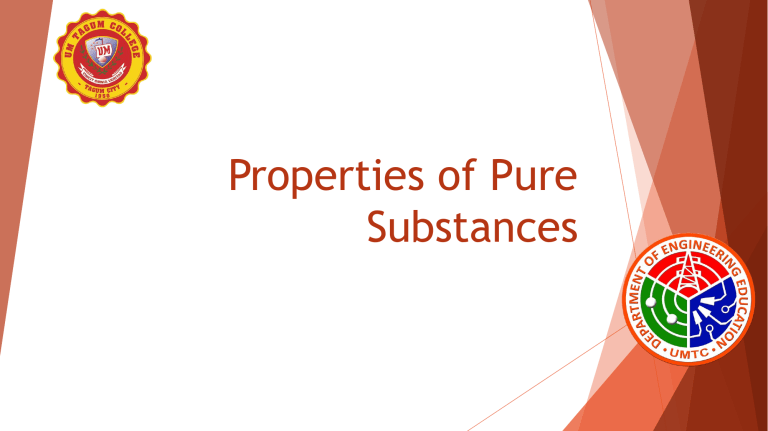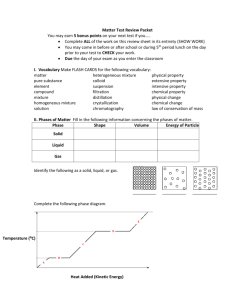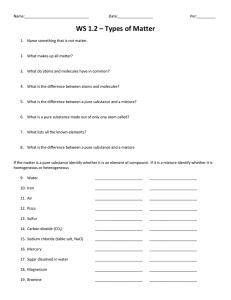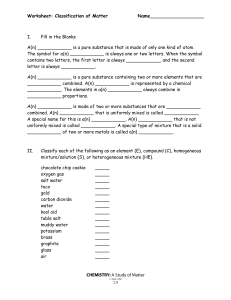
Properties of Pure Substances Pure Substance A substance that has a fixed chemical composition throughout is called pure substance. Ex: Water, nitrogen, helium, carbon dioxide Pure Substance However, it does not have to be of a single chemical element or compound. A mixture of various chemical elements or compounds also qualifies as a pure substance as long as the mixture is homogeneous. Ex: Air (gaseous)… Although it is mixture of several gases, it is often considered as pure substance because it has a uniform chemical composition. But oil and water (although mixture) is not a pure substance since oil is not soluble in water and it will collect on top of the water, forming two chemically dissimilar regions. Pure Substance A mixture of two or more phases of a pure substance is still a pure substance as long as the chemical composition of all phases is the same. Ex: mixture of ice and water… It is a pure substance because phases have the same chemical composition. A mixture of liquid air and gaseous air, however, is not a pure substance the composition of gaseous air is not the same as the liquid air, making the mixture not homogeneous. Phases of Pure Substance There are three principal phases: solid, liquid and gas. However, a substance may also have several phases within a principal phase each with a different molecular structure. Ex: carbon may exist as graphite or diamond in solid phase, helium has two liquid phase and iron has three solid phase. Phase: Solids Solids have strongest molecular bonds. Solids are closely packed three dimensional crystals. Their molecules do not move relative to each other Phase: Liquids Intermediate molecular bond strength Liquid molecular spacing is comparable to solids but their molecules can float about in groups. There is molecular order within the groups Phase: Gas Weakest molecular bond strength. Molecules in the gas phases are far apart, they have no ordered structure The molecules move randomly and collide with each other. Their molecules are at higher energy levels, they must release large amounts of energy to condense or freeze. Phase – Change Processes Of Pure Substances It is often important to consider the liquid to gas phase change process. Not so much solid to liquid because thermodynamics deals only with liquid to gases (or vice versa) to generate power. Gibb’s Phase Rule: The Phase Rule states that the number of known properties of a pure substance needed in order to also determine its other properties may be computed if the number of phases and the number of components present in the said substance is known. Gibb’s Phase Rule: P+F=C+2 P = number of phases (homogeneous region of matter) C = number of components (minimum number of chemical species required to prepare the system) F = degrees of freedom (number of properties that can be independently varied) For instance, if the degrees of freedom for a given system is equal to two, then, it means that knowing only two properties of the system will exactly determine the state of the system, hence, all its other properties will also be known. Examples: Determine the degrees of freedom for the following systems: 1. liquid water in equilibrium with its vapor 2. liquid water in equilibrium with a mixture of water vapor and nitrogen 3. liquid solution of alcohol in water in equilibrium with its vapor 4. decomposition of calcium carbonate 5. mixture of ice, liquid water, and gaseous water





